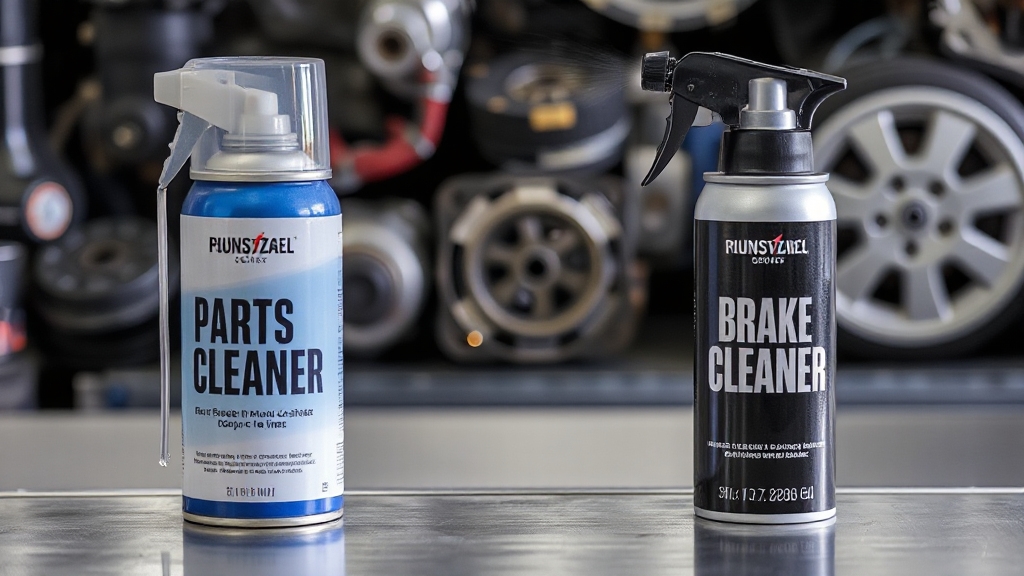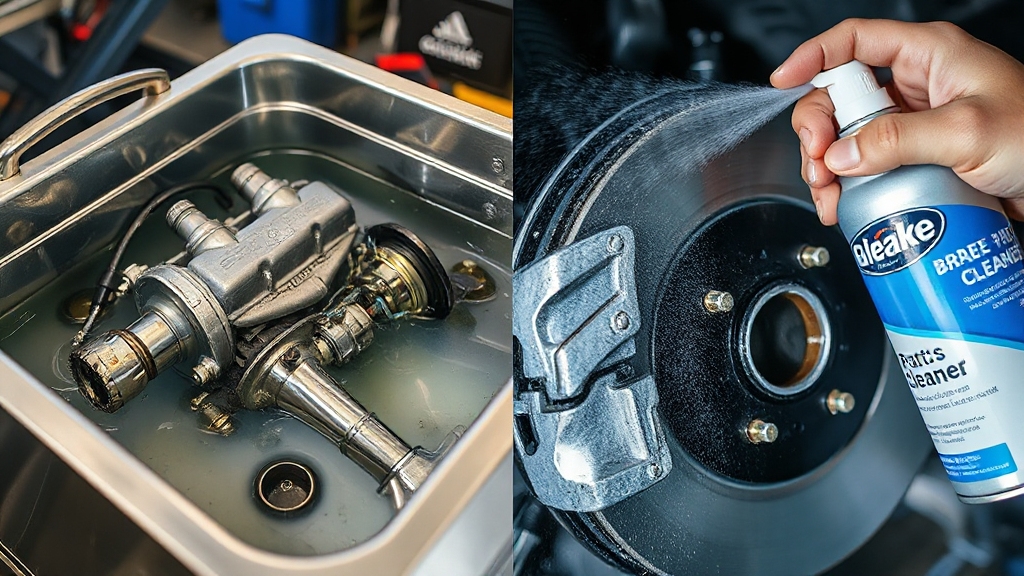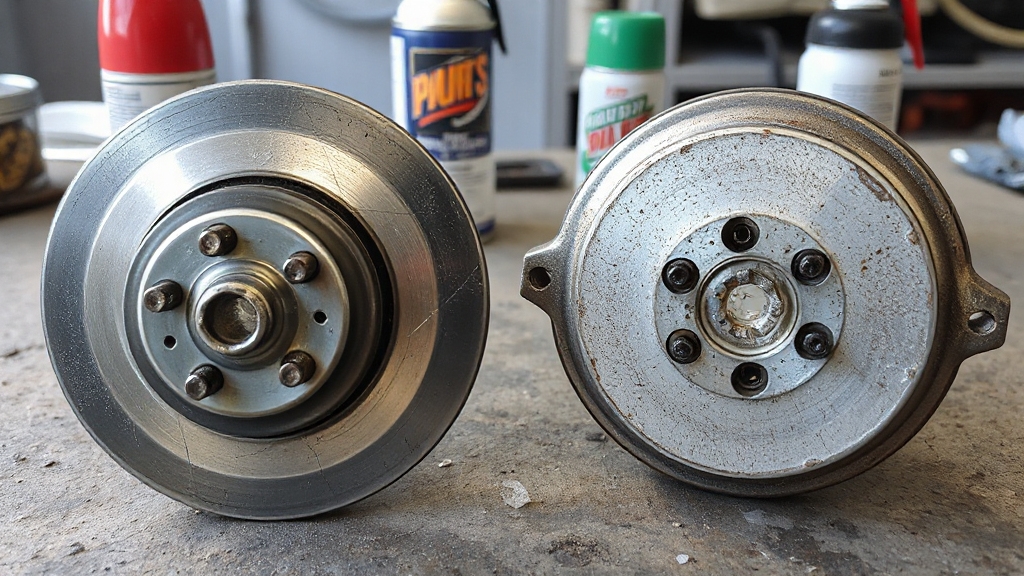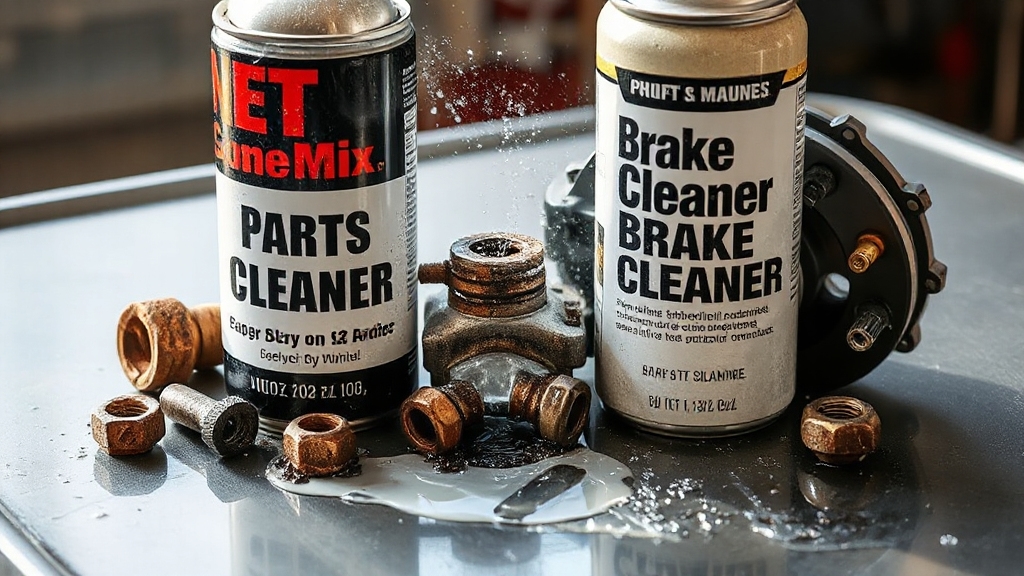You’ll find parts cleaners use petroleum-based solvents ideal for general degreasing on metals, plastics, and painted parts, but they may leave an oily residue. Brake cleaners contain fast-evaporating chlorinated or non-chlorinated solvents designed to remove brake dust and fluids without residue but can damage rubber or plastics if misused. Both require ventilation and proper disposal to meet safety and environmental rules. Understanding their chemical makeup and applications helps you choose the right product and avoid damage or compliance issues.
Key Takeaways
- Parts cleaners use petroleum-based solvents suitable for general degreasing of metals, plastics, and painted surfaces without rapid evaporation.
- Brake cleaners contain chlorinated or non-chlorinated solvents designed for fast evaporation, ideal for removing brake dust and fluid residues on metal parts.
- Chlorinated brake cleaners may damage rubber and plastic, while parts cleaners are formulated to be more material-compatible with diverse components.
- Brake cleaners evaporate quickly leaving minimal residue, whereas parts cleaners often leave a slight oily film if not wiped thoroughly.
- Environmental and safety regulations favor low-VOC, non-chlorinated brake cleaners, while parts cleaners require proper disposal to avoid contamination.
Chemical Composition Differences Between Parts Cleaners and Brake Cleaners

Although both parts cleaners and brake cleaners serve to remove contaminants, their chemical compositions differ markedly to suit their specific applications. Parts cleaners typically use petroleum-based hydrocarbons, which are less volatile and less flammable, suitable for general machinery cleaning.
In contrast, brake cleaners often contain chlorinated solvents or non-chlorinated alternatives, optimized for rapid evaporation and effective brake dust removal. Common active ingredients in brake cleaners include heptane (CAS 142-82-5) and isopropyl alcohol (CAS 67-63-0), though some formulations keep concentrations proprietary.
Brake cleaners comply with chemical inventories like DSL to meet environmental standards. While parts cleaners may release carbon oxides during combustion, brake cleaners maintain chemical stability under normal use but require careful handling due to higher reactivity and flammability.
These compositional differences define their distinct cleaning efficiencies and material compatibilities. Selecting the appropriate cleaner ensures optimal performance and chemical stability in varying conditions.
Safety Precautions When Using Parts and Brake Cleaners
When using parts and brake cleaners, you must prioritize safety due to their high flammability and chemical volatility. Always operate in well-ventilated areas to avoid inhaling toxic fumes, and wear NIOSH-approved respirators and protective clothing.
Keep both cleaners away from heat, sparks, open flames, and static discharge sources. Use non-sparking tools and prohibit smoking nearby.
Before handling, read safety labels thoroughly to understand risks and proper procedures. Store these chemicals in well-ventilated, cool environments away from ignition sources.
In case of skin or eye exposure, rinse immediately with water and seek medical attention if irritation persists. Contain spills with inert materials and dispose of them properly.
Maintain personal hygiene by washing hands and work clothes after use, and shower to remove contaminants.
Additionally, proper maintenance routines, including regular inspection of equipment and components, can significantly reduce risks associated with chemical exposure and ensure optimal performance.
Specific Applications for Parts Cleaners Versus Brake Cleaners

You’ll find parts cleaners excel at degreasing metal engine components, tools, and industrial machinery. Their effectiveness depends on proper maintenance practices to ensure improved handling and safety.
Brake cleaners target brake rotors, calipers, and drums for dust and fluid removal.
Each cleaner’s formulation suits specific materials—parts cleaners work broadly on metal surfaces but risk damaging paint or plastics; brake cleaners focus on brake-specific contaminants and evaporate rapidly on metal parts.
Brake cleaners are packaged mainly in metal spray cans due to their harmful effects on plastics. Understanding these intended uses and component compatibilities guarantees you select the right cleaner for efficient, safe maintenance.
Intended Cleaning Purposes
Since parts cleaners and brake cleaners serve distinct roles, understanding their intended purposes helps you select the right product for the task. Parts cleaners tackle general degreasing on engine components, tools, and metal surfaces, thriving in versatile workshop and industrial settings.
Brake cleaners focus on brake system components, removing dust, grease, and brake fluid residues without leaving residue, ensuring performance and safety.
It is important to note that many parts cleaners contain solvents like acetone and toluene, which can be aggressive on paint and plastics. Choosing the proper cleaner also involves considering the balance between performance benefits and material compatibility.
| Cleaning Purpose | Parts Cleaner | Brake Cleaner |
|---|---|---|
| Target Components | Engine parts, tools, metal surfaces | Brake discs, calipers, pads |
| Residue | May leave residue | Leaves no residue |
| Solvent Type | Multi-surface solvents | Brake-specific solvents with methanol |
| Application Setting | Workshops, industrial maintenance | Brake maintenance and preventive care |
| Propellant Use | Often includes CO2 propellants | Typically aerosol spray |
Component Compatibility
Understanding the intended cleaning purposes provides a foundation for selecting between parts cleaners and brake cleaners, but their component compatibility ultimately dictates their specific applications.
You must consider the materials involved to avoid damage or ineffective cleaning. Selecting the right cleaner also depends on the total base number of protection needed for the materials involved.
Parts cleaners suit a wide range of metals, plastics, rubber, and painted surfaces, often incorporating surfactants and rust inhibitors. Additionally, it is important to confirm compatibility with brake materials such as rubber, plastic, and metal to ensure safe use.
Brake cleaners, especially chlorinated types, can degrade plastics and rubber, so non-chlorinated formulas are preferred for sensitive brake components. Non-chlorinated brake cleaners are favored because they contain non-chlorinated solvents that reduce toxicity and health risks.
Here’s how you can apply this knowledge:
- Use parts cleaners for broad, multi-material assemblies requiring soaking or rinsing.
- Choose brake cleaners for precise, residue-free cleaning of brake pads, rotors, and calipers.
- Avoid chlorinated brake cleaners on rubber or plastic to prevent degradation over time.
Environmental Impact of Various Cleaning Solvents
You need to weigh the environmental trade-offs between chlorinated and non-chlorinated solvents in cleaning applications.
Chlorinated solvents persist longer, generate hazardous byproducts, and require strict disposal protocols. These cleaners are often more effective but pose greater environmental and regulatory challenges due to their chemical content. The precise rack and pinion construction of some cleaning systems can influence solvent efficiency and waste reduction.
Non-chlorinated alternatives degrade more readily and simplify waste management.
Proper disposal and recycling practices markedly influence environmental compliance and operational safety.
Chlorinated vs Non-Chlorinated
While both chlorinated and non-chlorinated cleaning solvents serve to remove contaminants effectively, their environmental impacts differ markedly. Chlorinated solvents contain VOCs like Methylene
Chloride and Trichloroethylene, which contribute considerably to ground-level smog, acid rain, and global warming. These solvents are also subject to strict regulations or bans in certain regions due to their hazardous nature.
Non-chlorinated solvents have lower VOC content, reducing air pollution but still pose some environmental risks. They are typically flammable, unlike many chlorinated options, which can affect handling and storage safety.
Consider these key points:
- Chlorinated solvents release higher VOCs, intensifying smog and climate impacts.
- Non-chlorinated solvents are less corrosive and safer for brake components, minimizing material degradation.
- Both solvent types can contaminate water, but chlorinated solvents pose more severe threats to ecosystems.
You should weigh effectiveness against environmental harm when choosing between chlorinated and non-chlorinated cleaners. Additionally, some non-chlorinated cleaners may contain toxic chemicals that require careful use and disposal.
Disposal and Recycling
Choosing between chlorinated and non-chlorinated solvents involves more than just performance and environmental toxicity; proper disposal and recycling considerably influence their overall impact.
You must follow federal and state regulations that often require permits and environmental impact assessments to manage hazardous solvent waste safely. It is crucial to avoid heating chlorinated solvents like Tetrachloroethylene, as this can produce deadly Phosgene gas, which poses severe health dangers.
Improper disposal risks air, water, and soil contamination, threatening ecosystems and human health. Recycling technologies, such as solvent distillation and chemical recovery, allow you to reuse solvents, reducing waste and cutting costs.
Employing closed-loop systems enhances energy efficiency and minimizes environmental harm. These practices align with industry trends emphasizing all-season capability to maintain performance without compromising safety or environmental standards.
Compliance prevents costly fines and supports green initiatives. As you handle solvents, prioritize these practices and stay informed through public awareness programs, advancing toward circular economy models and biodegradable solvent adoption to further reduce environmental footprints in parts and brake cleaner applications.
Comparing Effectiveness and Residue of Parts and Brake Cleaners

Although both parts cleaners and brake cleaners contain similar solvents like acetone, heptane, and toluene, their effectiveness and residue characteristics differ considerably due to formulation variations.
Brake cleaners rapidly dissolve grease, oil, and brake dust, evaporating quickly to leave minimal residue. Their fast evaporation is comparable to how premium oils like Mobil 1 EP maintain performance under extreme conditions.
Parts cleaners and brake cleaners share solvents but differ in effectiveness and residue due to formulation variations.
Parts cleaners, often with surfactants, target stubborn grime and carbon deposits but may leave a slight film requiring rinsing. This film helps prevent particle buildup inside carburetors, enhancing cleaning intervals.
Consider these differences:
- Brake cleaners dry faster, reducing downtime and residue risk on metal and painted surfaces.
- Parts cleaners provide thorough degreasing but can leave a thin oily film if not wiped.
- Methanol in brake cleaners enhances cleaning but risks damaging rubber components, limiting use.
Understanding these factors helps you select the right cleaner for specific automotive tasks.
Regulatory Standards and Proper Disposal Practices
Understanding the chemical composition and cleaning performance of parts and brake cleaners is only part of the equation. You must also navigate stringent regulatory standards governing VOC content, hazardous chemicals, and labeling. For instance, brake cleaners in
Canada and several U.S. states must contain less than 10% VOCs by weight, complying with EPA and state mandates that phase out chlorinated solvents due to toxicity.
Choosing non-chlorinated brake cleaners not only aids compliance but also promotes safer workplace environments. Many industries rely on products that meet industry performance standards to ensure both efficacy and safety.
Proper disposal is critical: used cleaners are hazardous waste and must be handled per local regulations—never poured down drains. You’re required to use PPE, ensure ventilation, and maintain disposal documentation.
Non-compliance risks hefty fines and environmental harm. To stay compliant, rely on low-VOC, non-chlorinated products, follow training protocols, and utilize manufacturer recycling programs whenever possible.
Frequently Asked Questions
Can Brake Cleaner Damage Painted Surfaces?
Yes, brake cleaner can damage painted surfaces because it contains strong solvents designed to dissolve grease and brake dust.
If it contacts paint, it may cause peeling, discoloration, or degradation.
You should rinse any affected area immediately with water to minimize damage.
To protect painted surfaces, always test brake cleaner on a small, hidden spot first and consider using gentler cleaners or protective covers during application.
Are Parts Cleaners Safe for Use on Plastic Components?
You should be cautious using parts cleaners on plastic components, as many solvents can degrade or warp plastics like polystyrene. Always verify the cleaner’s compatibility with the specific plastic type before use.
For sensitive plastics, opt for specialized plastic cleaners that evaporate without residue.
Wearing protective gear is essential, and manual cleaning might be safer for delicate or coated plastics to prevent damage and maintain component integrity.
How Long Should Cleaned Parts Dry Before Reassembly?
When you finish cleaning parts, imagine the solvent evaporating like morning dew under sunlight. You should let parts air dry for at least 5 to 10 minutes, depending on ambient temperature and humidity.
Non-chlorinated solvents may take longer. Confirm parts are completely dry before reassembly to prevent corrosion and ensure proper function.
Always work in well-ventilated areas to speed drying and avoid inhaling fumes, maintaining safety and effectiveness.
Do Brake Cleaners Remove Rust or Only Grease?
Brake cleaners primarily remove grease, oil, and brake fluid residues from brake components, not rust. While they can help eliminate light surface rust, they’re not designed for significant rust removal.
If you need to tackle deeper rust, consider specialized rust removers or methods like soaking rotors in vinegar.
Always wear safety gear when using brake cleaners, and avoid prolonged exposure on rubber seals, as the chemicals can degrade them.
Can Parts Cleaners Be Used on Electrical Connectors?
When you clean electrical connectors, imagine walking on a tightrope—one wrong step can cause damage.
You shouldn’t use parts cleaners on them because their chemicals might corrode metal, degrade insulation, or disrupt conductivity.
Instead, choose contact cleaners designed specifically for electronics; they evaporate quickly without residue and won’t harm sensitive components.
Always test a small area first and verify connectors dry completely to maintain performance and safety.
Cleaner Decisions, Cleaner Outcomes
Choosing between parts cleaner and brake cleaner is like picking the right tool from a mechanic’s arsenal—each solvent has its unique chemistry and purpose. You’ll want to handle them with care, respecting safety protocols and environmental regulations to avoid sparks in your workflow. Understanding their specific applications, residue levels, and disposal methods guarantees you maintain both performance and compliance, keeping your workspace efficient and your conscience clear. Use the right cleaner for the right job.








